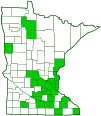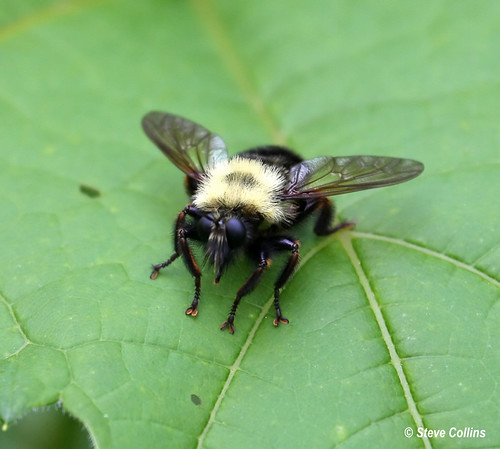bee-mimic robber fly
(Laphria thoracica)
Conservation • Description • Habitat • Biology • Distribution • Taxonomy
Conservation Status |
|
|||||||
| IUCN Red List | not listed |
|||||||
| NatureServe | not listed |
|||||||
| Minnesota | not listed |
|||||||
Description |
||
Laphria thoracica is a large bee-mimic robber fly. It occurs in the United States from the northeast to the Midwest and south to Tennessee, and in adjacent Canadian provinces. There are at least 33 Laphria species in the eastern United States. Laphria thoracica is probably the most common. It is uncommon in Minnesota, where it is at the western extent of its range. Adults are robust, very hairy, and about ¾″ long. The thorax and abdomen are partially covered with long yellow hairs making it resemble a bumble bee. It is a mimic of common eastern bumble bee (Bombus impatiens), half-black bumble bee (B. vagans), and lemon cuckoo bumble bee (B. citrinus). The thorax is stout and black. It is densely covered with long, erect, yellow hairs except for a small, round, black, bare spot in the middle. The yellow hairs extend in an arc from the front of the thorax to the side below the wing base. The abdomen widens beyond the middle. The amount of yellow on the abdomen varies. On the female, the abdomen is entirely black. On the male, segment 1 is always black, and segments 2, 3, and 4 are often completely or partially covered with long yellow hairs. There are two large compound eyes and three small simple eyes (ocelli). The compound eyes extend above the level of the top of the head (vertex), making the head appear hollowed out between the eyes when viewed from the front. The ocelli are arranged in a triangle on a prominent rounded projection (tubercle) in the middle of the head between the compound eyes. The upper face is covered with long, erect hairs that may be mostly yellow, mostly black, or entirely black. There is a dense mustache of long stiff bristles (mystax) on the face between the compound eyes at the lower margin, and a cluster of forward-directed bristles (a “beard”) on the lower part of the face. The mystax and beard are mostly black with a few scattered yellow hairs. The antennae have 3 segments. The third segment is elongated. The legs are stout and black. They are covered with black hairs with patches of orange hairs. The last part of the leg (tarsus), corresponding to the foot, has five segments. The last segment has 2 pads. On the wing, the first and second branches of the radial sector vein (R1 and R2+3) join before the end of R1 creating a closed cell that does not reach the margin. |
||
Size |
||
Total length: about ¾″ |
||
Similar Species |
||
Habitat |
||
Woodland edges |
||
Biology |
||
Season |
||
Late May through July |
||
Behavior |
||
It buzzes loudly when it flies. It captures its prey in flight. It uses its sharp proboscis to pierce its prey, inject enzymes which liquefy the prey’s organs, and suck out the resulting liquid. It can deliver a painful bite when handled. |
||
Life Cycle |
||
Larvae are borers in moist, dead wood. |
||
Larva Food |
||
Beetle larvae |
||
Adult Food |
||
Bees and beetles |
||
Distribution |
||||
|
Sources |
|||
| 6/22/2022 | ||||
Occurrence |
||||
|
||||
Taxonomy |
|||
Order |
Diptera (flies) | ||
Suborder |
Brachycera | ||
Infraorder |
Orthorrhapha | ||
Superfamily |
Asiloidea | ||
Family |
Asilidae (robber flies) | ||
Subfamily |
Laphriinae | ||
Tribe |
Laphriini | ||
Genus |
|||
Synonyms |
|||
Dasyllis thoracica Laphria alcanor Laphria fulvithorax |
|||
Common Names |
|||
Few of the North American Laphria species have a common name. The common name for the genus is bee-mimic robber fly, and will be used here for convenience. |
|||
Glossary
Mystax
On flies, especially in the family Asilidae, a patch of bristles or hairs (mustache) immediately above the mouth.
Ocellus
Simple eye; an eye with a single lens. Plural: ocelli.
Tarsus
On insects, the last two to five subdivisions of the leg, attached to the tibia; the foot. On spiders, the last segment of the leg. Plural: tarsi.
Visitor Photos |
|||||
Share your photo of this insect. |
|||||
| This button not working for you? Simply email us at info@MinnesotaSeasons.com. Attach one or more photos and, if you like, a caption. |
|||||
Babette Kis |
|||||
Laphria thoracica bee like robberfly Laphria thoracica, bee-like robberfly, with bumblebee prey, near the hedgerow at Barnes Prairie, Racine Co., WI. Photos taken June 29, 2020.
|
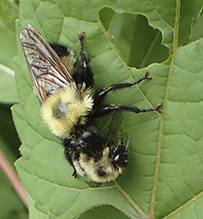 |
||||
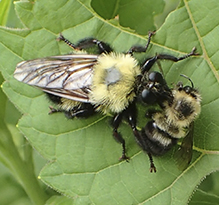 |
|||||
Seirra Quinn |
|||||
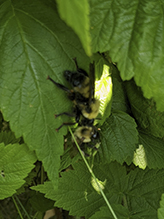 |
|||||
Alfredo Colon |
|||||
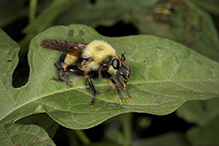 |
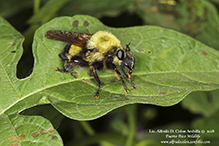 |
||||
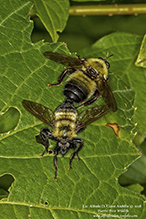 |
|||||
MinnesotaSeasons.com Photos |
|||||
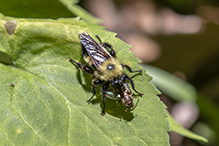 |
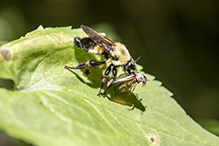 |
||||
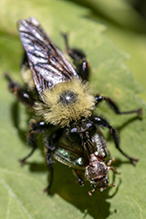 |
|||||

Visitor Videos |
|||
Share your video of this insect. |
|||
| This button not working for you? Simply email us at info@MinnesotaSeasons.com. Attach a video, a YouTube link, or a cloud storage link. |
|||
Other Videos |
|||
| bee-like robber Fly (Asilidae: Laphria thoracica) Anterior View Carl Barrentine |
|||
About
Published on Jun 12, 2012 Photographed at the Turtle River State Park, North Dakota (12 June 1012). This species of robber fly is a good mimic of this local bumble bee: https://www.youtube.com/watch?v=zbD04dxYpTM |
|||
| bee-like robber Fly (Asilidae: Laphria thoracica) Carl Barrentine |
|||
About
Published on Sep 13, 2009 Photographed at the Kellys Slough NWR, North Dakota (13 September 2009). |
|||
| Predators: The Watchful Robber Fly Carl Barrentine |
|||
About
Published on Jul 12, 2015 This short film introduces a robber fly that mimics a bumble bee (Family Asilidae), Laphria thoracica. This very large raptor-like fly is known to feed on honey bees. Filmed at Grand Forks, North Dakota (09 July 2015). A Lucretius Production. |
|||


Created: 12/1/2018
Last Updated:
